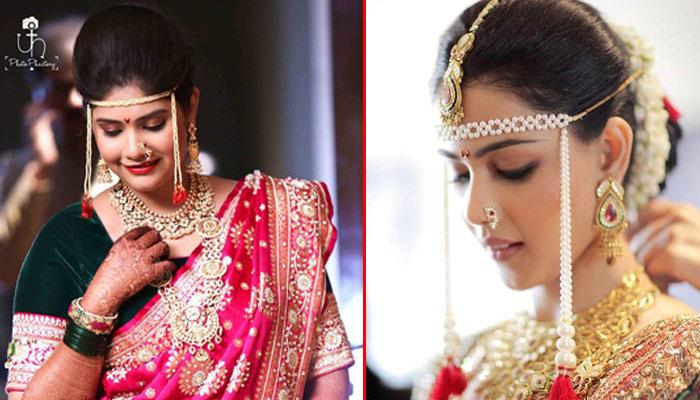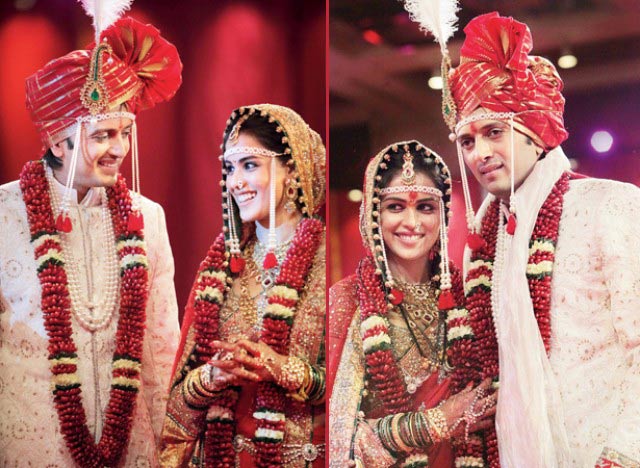About Us
Advertise With Us
RSS Feed | Content Syndication
Terms & Conditions
Privacy Policy
Contact Us
BollywoodShaadis.com © 2025, Red Hot Web Gems (I) Pvt Ltd, All Rights Reserved.

Dressed in a beautiful yellow saree with a golden border, hair tied in a bun and decorated with pearl ornaments and gajra, she is a gorgeous Maharashtrian bride. Unlike the other Indian communities, where the brides usually wear red, this saree, traditionally a Paithani, comes in very typical colours of golden yellow, leaf green or aubergine.
Apart from the attractive sunshine yellow of the saree, what sets her apart are the traditional ornaments that she dons. Maharashtrians mostly prefer blending in pearl jewellery along with gold, which has several references in Marathi literature and poetry as well. Here are the typical adornments of a traditional Maharashtrian bride.
Recommended Read: The Sacred Rituals And Traditions That Make Maharashtrian Weddings A Very Beautiful Affair

This is a unisex ornament, worn by the bride as well as the groom. It is basically a string (sometimes two) of pearls, tied horizontally across the forehead from the temple. There are two more pearl lines that drop from either side of the forehead to the shoulders, beautifully framing the face. The mundavalya are tied after the bride is ready to walk to the mandap. This literally means that she is ready to get married.
Must See: 5 Best Workout Ideas For Plus Size Brides To Lose Weight Fast

This is an absolute must for a Maharashtrian bride. It is a choker with 3-4 pearl lines that sit firmly onto it. The off-white pearls are accompanied by a few coloured pearls just to add to the beauty of the neckpiece. This essentially comes with a resham string that holds it and can be adjusted at the back of the neck to tighten or loosen it.
Continue reading below
Do Read: Most Common Wedding Colour Mistakes And Combinations You Should Totally Avoid

As the name suggests, this ornament is originally from the city of Kolhapur in Maharashtra. This necklace is suggestive of the woman’s marital status and is gifted by the groom’s family. In many Maharashtrian communities, a Kolhapuri saaz is as important as the mangalsutra, and many women in rural Maharashtra still wear it every day. It consists of gold beads (Jav mani), gold elements of leaves, petals etc., and a round pendant with a red stone in the centre, woven in a gold wire.
Traditionally, this necklace included 21 separate design elements, of which 10 are a reflection of Lord Vishnu’s avatars, 8 are auspicious patterns or ashtamangal, and two are ruby and emeralds. The last piece is the taviz to protect from evil.

Maharashtrian bridal chooda is very different than the red chooda. It has glass bangles in green, a symbol of fertility, new life and creativity. It is customary to wear these in odd numbers, and in different numbers in both hands. For example, 11 in one and 13 in the other or 13 and 17, and so on. Solid gold bangles called patlya and carved gold kadas called tode are worn along with the green glass bangles.
The bride wears the chooda amidst much celebration after the mehendi. The patlya and tode, often gifted by the groom’s family, depict the financial status of the family. Solid, heavy gold rather than intricate carvings are usually preferred.
Interesting: 8 Quick And Easy Navratri-Special Recipes For Newlywed Brides To Impress Their In-Laws

Vaaki or armlet is an essential for the Maharashtrian bride. Ideally worn one on each arm, many brides these days wear just one vaaki. A traditional design is in flat, solid gold with precious stones in the centre.

Just like the mundavalya and the tanmani, the nath makes a Maharashtrian bride different than the rest. This traditional nosepiece has pearls woven in a typical Paisley shape, and has a white stone in the centre. The more extravagant families are known to have a diamond for this white stone. There is a red stone or a red-coloured pearl that is also a part of the typical design.
A nath comes in different styles, depending on the part of Maharashtra the bride belongs to. A brahmani nath is the most popular design, and is studded with basra moti and emeralds. Just like the patlya and tode, the nath also stands for the financial status of the family.
You Might Like: 10 Fun Wedding Traditions From All Over The World That You May Want At Your Wedding

Even though the designs have evolved and changed over the years, the meaning and importance of the mangasultra have not changed. It literally means mangal (holy) and sutra (thread). The black beads string end with two golden cups, each standing for the parents’ and the in-laws’ home. It literally means that the bride’s new home and her parents’ home are tied together in a delicate thread. Each golden cup is filled with haldi and kumkum before the husband ties it around the bride’s neck.

The bride ties her hair into a neat, round bun (ambada) and embellishes it with traditional hair jewels called khopa or bejewelled pins, followed by jasmine gajras.

Jodvi or tow-rings, always in silver, are gifted by the mother-in-law and signify the bride’s entry in the new household. These are a must for every Maharashtrian bride.
Recommended Read: Expert Tips To Take Care Of Your Precious Bridal Jewellery
The diversity that India has when it comes to cultures and traditions is beyond plain exciting! Every community and region in India has a different story to narrate. These were the absolute essentials for a traditional Maharashtrian bride.
If you would like to read about rituals and wedding essentials from other Indian communities, let us know in the comments section below.
